Tenkara fly fishing is a minimalist type of fly fishing used for mountain stream trout fishing. With an emphasis on simple lightweight gear, this form of fishing is perfect for backpackers who want a deeper wilderness experience in the backcountry. Here are 10 beginner Tenkara tips that I learned as a new Tenkara fisherman which will set you on the right track and get you catching fish with a little practice.
1. Take a Guided Lesson
Take a Tenkara lesson from a guide. They’ll teach you how to set up your rod, how to cast, explain to you where trout like to hide, and what to do when you catch one. Tenkara isn’t nearly as difficult to pick up as more traditional fly fishing with a rod, but you’ll expedite your learning process by getting a few hours of coaching on a river. After that, you can pretty much pick things up on your own with a little perseverance.

2. Get Out and Fish as Much as Possible
The key to becoming a good fisherman is to try a lot of different things and fail fast. The sooner you get all of your failed experiments behind you, the sooner you’ll figure out what works and what doesn’t. How to read water, how to stalk trout, which flies to fish, etc. There are a lot of different skills to pick up and integrate and you’ll get better faster if you get out frequently. Don’t get discouraged if you don’t catch fish right away. You will.

3. Find Knots You Can Remember
You need three knots for Tenkara fishing: the knot you tie your line to the rod with, the knot you tie the tippet to the line with, and the knot you tie your fly to the tippet. Figuring out what knots you need can be very confusing since there is so much conflicting information about the best knots to use on the Internet. My advice: find ones you can remember and tie consistently. I use three very easy-to-tie knots:
- An arbor knot to tie my line to the rod’s lillian
- A triple surgeons knot to tie my tippet to the line.
- Modified cinch knot to tie my fly to the tippet.
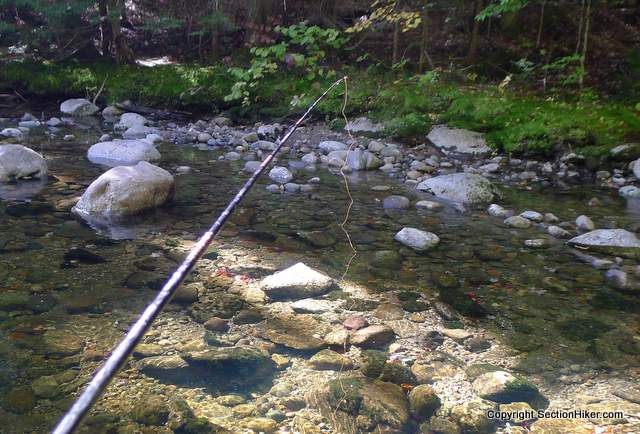
4. Use a High Visibility Level Line
There are two kinds of fishing line: traditional woven line and flourocarbon level line. I got started with traditional woven Tenkara line but quickly switched to high visibility flourocarbon line because it’s easier to see against the water and because you can feel a lot more fish strikes than you can with a traditional line. Strike detection is one of the keys to landing fish and the more sensitive your line, the more fish you’ll catch.

5. Use a Short Line
If you have an 11 foot rod, try fishing with a 9 foot line and a 3-4 foot tippet. It will be a lot easier to cast and you’ll have much more control over the placement of your fly. I got this tip from Chris Stewart at TenkaraBum and it made a huge difference in my ability to catch fish (see Long Rod Short Line). There’s a lot to learn from Chris’ experiences and he sells some excellent Tenkara products and supplies as well.
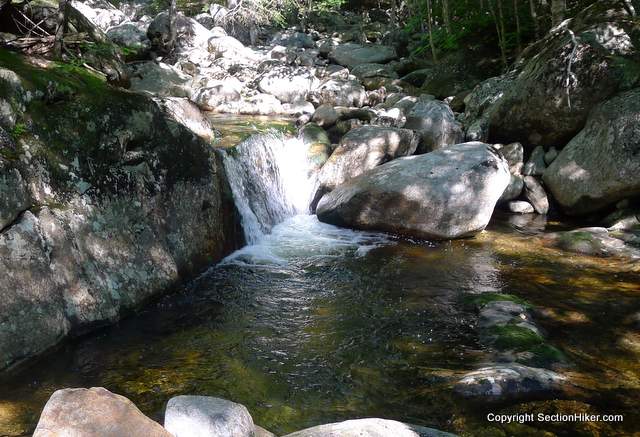
6. Learn Where Trout Hide
If you fish in mountain streams, you’ll never see trout rising (on a pond or lake.) Instead, you need to learn where trout are likely to lurk in the stream bed and fish those spots. Trout prefer cold, oxygenated water that has some sort of surface disturbance (bubbles, riffles) so predators can’t see them from overhead. The water also needs to be deep enough for them to hide, but not so deep that they hug the bottom and never come up to hit your fly. While it’s not Tenkara specific, I highly recommend reading Dave Hughes’ classic “Reading Trout Water”, which explains and illustrates where trout can be found in different river and stream types. It’s a fantastic, richly illustrated book.
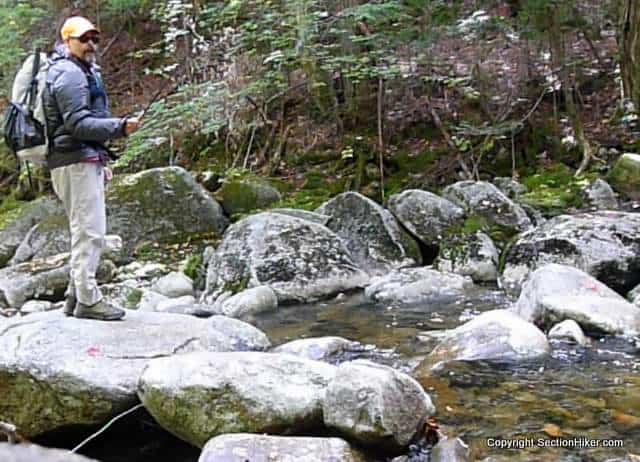
7. Wear Polarized Sunglasses
Polarized sunglasses help you see your fly and fish that are swimming underwater. It’s like using X-ray vision to see underwater.
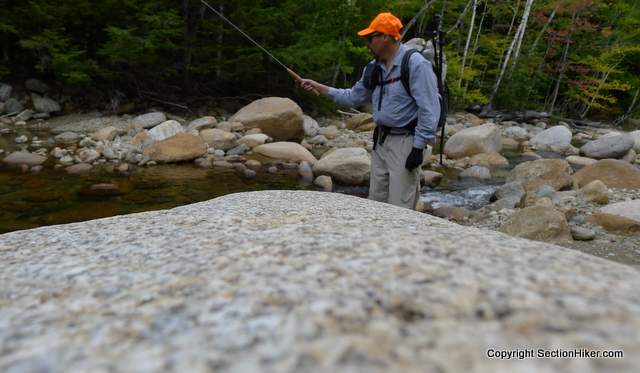
8. Keep your Feet Dry
Stealth is the name of the game with Tenkara fly fishing. Stay out of the water, wear sky or earth-toned clothing and don’t let the fish see you when you’re stalking them. While it’s tempting to wade in a stream, keep your feet dry. If you wade, you’ll scare the fish off.
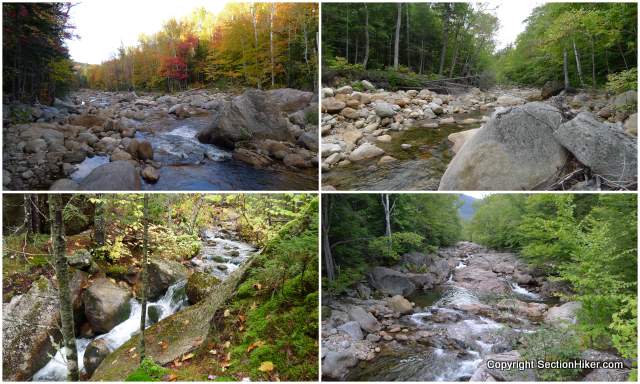
9. Fish Lots of Different Rivers and Streams
Get out and fish a wide variety of rivers and streams at all kinds of different water levels so you learn the types of river or stream conditions that make for good Tenkara fishing and when you’d be better off going somewhere else. You can get a list of trout-holding rivers and streams in your area by buying yourself the Delorme Atlas and Gazetteer for your state. In addition to rivers, Delorme Gazetteers have excellent, highly detailed maps of the backcountry roads you’ll need to drive down to get to these rivers. For example, I keep the Gazetteers for New Hampshire, Massachusetts, Maine and Vermont in my car for easy reference.

10. Tie Your Own Flies
In addition to saving lots of money, tying your own flies will teach you a lot about trout feeding habits and the kinds of insects that they like to eat. It’s a fascinating subject if you like learning about bugs and fish. I recommend that you buy yourself a good traditional fly tying kit (with a good manual) that lets you tie Tenkara flies as well as more traditional fly fishing patterns, since you’ll learn about a lot of materials and fly tying techniques. While you can just fish traditional Tenkara flies, it’s fun to create your own patterns and fish them too. I taught myself how to tie flies using the LL Bean Double L Fly Tying Kit, which I highly recommend, but there are probably lots of other good kits available too.
See Also:
SectionHiker is reader-supported. We only make money if you purchase a product through our affiliate links. Help us continue to test and write unsponsored and independent gear reviews, beginner FAQs, and free hiking guides. SectionHiker.com Backpacking Gear Reviews and FAQs
SectionHiker.com Backpacking Gear Reviews and FAQs 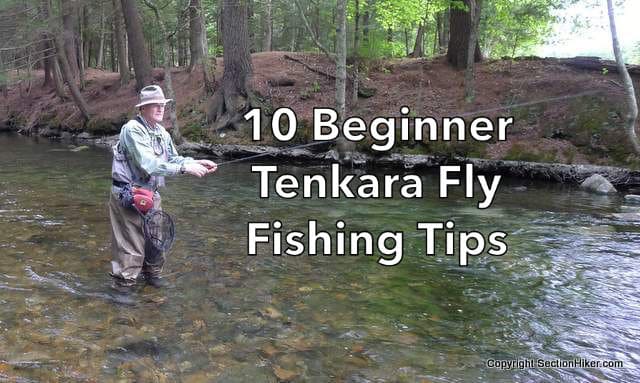
Good tips, Philip.
Had a busy fishing year, despite the northeastern drought. Fished 20 separate rivers and brooks, some multiple times. Challenging year to teach myself the skill, but I do catch fish finally, so it seems to be working!
Ah but how many of those 20 separate locations did you catch at?
When does trout season end in the whites?
Eight. I’ll be publishing a diary of all 20 rivers next week. I attribute my lack of success at the beginning of the season to lack of skills, rather than lack of fish.
The season is waning now, mainly because of a continued drought. The rivers, even the big ones are running so low. There’s hardly any water at all! Hopefully we’ll get some snow this winter to refresh the watersheds.
Good post…I’ve just recently started my journey into tenkara fly fishing as well (with absolutely zero background in western fly fishing). A couple of things I found noteworthy:
1) I’ve absolutely seen fish rise on small mountain streams, so I was surprised to read your comment about that. I still agree that reading water is critical, but it’s not true that you won’t see rising fish on streams (especially in pools).
2) I’m not sure I agree with the comment about not wading. I’ve had success from day 1 wading in small streams (I also find it a bit ironic that your guide/instructor is wading in the initial picture!).
1) I never have.I avoid pools, since I can’t get my unweighted line deep enough without a pourover. Do you weight your lines?
2) Good point! Still, he’s fishing in an articifical unnatural river fed by a bottom flowing damn that’s got a ton of fish in it from an upstream reservoir. Nothing like what we have in the mountains though,,,,
So far, I’ve mainly fished dry flies on the surface or tenkara flies just below the surface. Only use a furled tenkara line and don’t weight my flies. I’ve had plenty of takes/connections right on the surface with my dries.
Maybe I’ll have better luck when this drought is over. Where do you fish?
Have fished in Southwestern PA and Blue Ridge Mountains in VA (Shenandoah Nat’l Park and the surrounding area).
Philip – I assume you have my email from my posts…feel free to ping me if you want to talk offline with another newbie tenkara fisherman (or if you’re ever on a section hike in VA and want some company fishing).
Mike- I was just thinking that. I have plans to section hike PA->Front Royal next spring. I hadn’t planned on bring my rod because fishing erodes my hiking time so badly, but it might be good for a few zeros days…:-)
They say a bad day fishing is better than a good day at the office. Of course, your office is the outdoors…
Took a picture of my office on my last trip the other day. Lawn chair next to campfire with a hammock hanging in the tree next to the river I was fly fishing. It was 20 some degrees out, but I was still happy as a clam!
Philip – Revisiting an old post…I caught a dozen brookies less than 2 miles from the AT in Shenandoah Nat’l Park last weekend. Mayflies have started to hatch and the fish were all over the dry flies I used.
Nice!
Philip, good stuff. I’m looking into Tenkara for spring. My shoulder no longer allows a perfect cast ( I don’t think I ever really had one.) I like the idea of working some smaller out of the way stream.
Well done Philip, here in New Zealand tenkara is really not a legal way to fish however there are quite a few who fish tenkara anyway. Tenkara is not just for mountain streams though, it works just the same on lakes, rivers and ponds and the same basic principles apply: stalk your fish or possible lies.
I carry a 4.5 m rod which is only 33 cm when down and weighs just 85 g. This has the advantage that it can be used at full length or at roughly 30 cm increments down to a couple of meters and with the extra length larger fish (to 3.5/4 lb) are able to be landed. With the long rod if pull is kept directly above a fish will not run but circle most times.
As in all disciplines skill is gained by practice, practice, practice. Practice slow stalking, very accurate casting and use flies that will get to the feed zone fast. Tenkara used as a short line “French Nymph” technique is deadly in fast pocket water.
Hi Tony, I’m returning home to NZ for a month at Christmas, after being away for many years..
I’m aware of the law etc as for fishing/not using tenara in NZ, but had decided to leave my tenkara rod at home. You have got me thinking about bringing it
Which part of NZ are you in?
Would you be able to suggest any rivers?
Thanks
South Island back country feeder streams are prime waters seldom if ever fished and with some very surprising browns to stalk. Back pack and fish what ever comes up at the days end, Great fun!
I think my left hand–my line hand–would go a bit crazy if I tried a Tenkara rod. That said, tying Tenkara flies is fun and they work. It’s kind of interesting to consider that the old, traditional Tenkara and the Scottish and North Country patterns were tied with the same material: just silk thread and bird hackle. Great minds and all that. Good post. Solid advice.
Great post, I just read Chris’ trip report from your recent weekend fishing together. Looks great. I should come up to MA and fish some time, my family has land near North Adams and its been too long since I’ve visited.
These tips are good “no nonsense” tips and they should all be helpful to Tenkara noobs everywhere. Thanks for sharing. Beautiful photos, too.
Great advice for beginners learning to fly fish. Having the right materials is the best way for you have a successful trip. Thanks for sharing!
I love the tip on taking a guided lesson! I’m going to be going on my first fly-fishing trip soon, and I was feeling rather anxious about it until another member of the group told me that the place we were going has the option of taking a guide along. Now I’m just excited to go and learn about this fun sport so that I can join my friends more often.
Great article. I’ll definitely be applying several of these tips.
I don’t fish Tenkara since I’ve owned and fished regular fly fishing for many decades and have run out of room in the closet, I like your tips, but would suggest instead of a clinch knot folks learn either the Swirl or the Davies knots to tie their fly onto their tippet,( lots of You Tubes). They’re smaller, simpler, more tippet efficient, as strong and with little practice you can tie them in the dark … or with old eyes!
I would add this. Make sure that Tenkara is allowed on the stream, pond, section, lake etc. The state of NH doesn’t recognize Tenkara as fly fishing.
That’s not true. A fly is a fly. Doesn’t seem to bother the fishing guides or stores running trips and selling Tenkara gear in New Hampshire. I’ve been fishing Tenkara for close to a decade and never been hassled.
Sorry Philip but you’re incorrect. If one attaches a fly to a live worm that doesn’t mean that person is fly fishing. NH classifies fly fishing as a fly rod, fly reel and fly line. This is directly from the F&G regs: Fly-fishing: Fishing by trolling or casting with only fly rod, fly reel, and fly line combination with an artificial fly or cast of artificial flies attached, and does not include the use of spinning, spincast, and casting rods and reels and lead core lines.
Even if you think it’s enforced, it’s only relevant on streams that are posted fly fishing only which are achingly few. I give it no thought, since I fish mountain streams almost exclusively where it’s perfectly legal to fish with whatever method you want.
I didnt say that Tenkara was illegal or unlawful to use or sell.. There are rivers and streams with special regs where its fly fishing only. NH doesnt classify Tenkara as fly fishing
I don’t know if its enforced or not. I’m merely stating that people should be aware that there are regulations in place and that they should be aware before they go fishing in any particular area. Especially for a beginner which is what I believe your target audience was for this article…
Have been interested in Tenkara since you wrote about it, and my wife got me a nice kit for Christmas. Taking advice you gave about lessons, I researched online and found a nice site, Red Brook Tenkara, and registered for a Tenkara campout in the Whites at Barnes Field in June. Lessons, seminars, and Tenkara swag raffles and give aways. Was only $55 for two nights? Thought it might be of interest to you, or some of the readers. Website is: Red Brook Tenkara for info. Thanks.
Thanks for the tip!